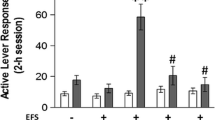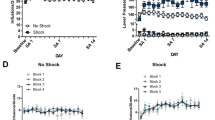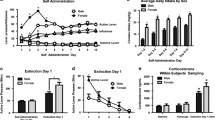Abstract
Rationale
The dopamine (DA) D3 receptor is preferentially expressed in the mesolimbic system. We have previously shown that selective D3 receptor blockade by the novel D3 antagonist SB-277011A inhibits cocaine’s reinforcing action and cocaine-induced reinstatement of cocaine-seeking behavior.
Objective
In the present study, we investigated whether SB-277011A similarly inhibits stress-induced reinstatement of cocaine-seeking behavior.
Methods
Rats were allowed to self-administer cocaine (0.5 mg/kg per infusion, 3 h per session) for 10–14 days, followed by a once-daily extinction session for 7–14 days during which saline was substituted for cocaine. Extinction criteria were fewer than ten lever-presses per 3-h session for at least 3 consecutive days. After cocaine-seeking behavior was extinguished, each animal was tested twice for footshock-stress-induced reinstatement, once with vehicle (25% hydroxypropyl-β-cyclodextrin) and once with one of three doses of SB-277011A in counterbalanced fashion.
Results
During the last 3 days of cocaine self-administration (SA), active lever-presses were approximately 100 per session under fixed-ratio 2 reinforcement (∼25 mg/kg cocaine per session). After extinction, intermittent footshock (10 min, 0.5 mA, 0.5 s on with a mean inter-shock interval of 40 s) robustly reinstated the cocaine-seeking behavior (8.4±3.6 active lever-presses in last extinction session to 35.3±5.2 in animals after footshock stress). Intraperitoneal (IP) injections of SB-277011A (3, 6, and 12 mg/kg) dose-dependently blocked stress-induced reinstatement of cocaine-seeking. Reinstatement was also blocked by microinjections of SB-277011A (1.5 μg/0.5 μl per side) bilaterally into the nucleus accumbens, but not into the dorsal striatum.
Conclusions
The mesolimic DA D3 receptor plays an important role in mediating stress-induced reinstatement.




Similar content being viewed by others
References
Andreoli M, Tessari M, Pilla M, Valerio E, Hagan JJ, Heidbreder CA (2003) Selective antagonism at dopamine D3 receptors prevents nicotine-triggered relapse to nicotine-seeking behavior. Neuropsychopharmacology 28:1272–1280
Ashby CR Jr, Paul M, Gardner EL, Heidbreder CA, Hagan JJ (2003) Acute administration of the selective D3 receptor antagonist SB-277011-A blocks the acquisition and expression of the conditioned place preference response to heroin in male rats. Synapse 48:154–156
Austin NE, Baldwin SJ, Cutler L, Deeks N, Kelly PJ, Nash M, Shardlow CE, Stemp G, Thewlis K, Ayrton A, Jeffrey P (2001) Pharmacokinetics of the novel, high-affinity and selective dopamine D3 receptor antagonist SB-277011 in rat, dog and monkey: in vitro/in vivo correlation and the role of aldehyde oxidase. Xenobiotica 31:677–686
Bouthenet M-L, Souil E, Martres M-P, Sokoloff P, Giros B, Schwartz J-C (1991) Localization of dopamine D3 receptor mRNA in the rat brain using in situ hybridization histochemistry: comparison with dopamine D2 receptor mRNA. Brain Res 564:203–219
Caine SB, Koob GF (1993) Modulation of cocaine self-administration in the rat through D3 dopamine receptors. Science 260:1814–1816
Caine SB, Koob GF (1995) Pretreatment with the dopamine agonist 7-OH DPAT shifts the cocaine self-administration dose-effect function to the left under different schedules in the rat. Behav Pharmacol 6:333–347
Caine SB, Koob GF, Parsons LH, Everitt BJ, Schwartz J-C, Sokoloff P (1997) D3 receptor test in vitro predicts decreased cocaine self-administration in rats. Neuroreport 8:2373–2377
Campiani G, Butini S, Trotta F, Fattorusso C, Catalanotti B, Aiello F, Gemma S, Nacci V, Novellino E, Stark JA, Cagnotto A, Fumagalli E, Carnovali F, Cervo L, Mennini T (2003) Synthesis and pharmacological evaluation of potent and highly selective D3 receptor ligands: inhibition of cocaine-seeking behavior and the role of dopamine D3/D2 receptors. J Med Chem 46:3822–3839
Carter BL, Tiffany ST (1999) Meta-analysis of cue-reactivity in addiction research. Addiction 94:327–340
Chen J, Marmur R, Pulles A, Paredes W, Gardner EL (1993) Ventral tegmental microinjection of Δ9-tetrahydrocannabinol enhances ventral tegmental somatodendritic dopamine levels but not forebrain dopamine levels: evidence for local neural action by marijuana’s psychoactive ingredient. Brain Res 621:65–70
Depoortere R, Perrault G, Sanger DJ (1999) Intracranial self-stimulation under a progressive-ratio schedule in rats: effects of strength of stimulation, d-amphetamine, 7-OH-DPAT and haloperidol. Psychopharmacology 142:221–229
Diaz J, Lévesque D, Lammers CH, Griffon N, Martres M-P, Schwartz J-C, Sokoloff P (1995) Phenotypical characterization of neurons expressing the dopamine D3 receptor in the rat brain. Neuroscience 65:731–745
Di Ciano P, Underwood RJ, Hagan JJ, Everitt BJ (2003) Attenuation of cue-controlled cocaine-seeking by a selective D3 dopamine receptor antagonist SB-277011-A. Neuropsychopharmacology 28:329–338
Epstein DH, Preston KL (2003) The reinstatement model and relapse prevention: a clinical perspective. Psychopharmacology 168:31–41
Greengard P (2001) The neurobiology of dopamine signaling. Biosci Rep 21:247–269
Kalivas PW, Duffy P (1995) Selective activation of dopamine transmission in the shell of the nucleus accumbens by stress. Brain Res 675:325–328
Katz JL, Higgins ST (2003) The validity of the reinstatement model of craving and relapse to drug use. Psychopharmacology 168:21–30
Lamas X, Negus SS, Nader MA, Mello NK (1996) Effects of the putative dopamine D3 receptor agonist 7-OH-DPAT in rhesus monkeys trained to discriminate cocaine from saline. Psychopharmacology 124:306–314
Landwehrmeyer B, Mengod G, Palacios JM (1993) Differential visualization of dopamine D2 and D3 receptor sites in rat brain. A comparative study using in situ hybridization histochemistry and ligand binding autoradiography. Eur J Neurosci 5:145–153
Lavicky J, Dunn AJ (1993) Corticotropin-releasing factor stimulates catecholamine release in hypothalamus and prefrontal cortex in freely moving rats as assessed by microdialysis. J Neurochem 60:602–612
Leri F, Flores J, Rodaros D, Stewart J (2002) Blockade of stress-induced but not cocaine-induced reinstatement by infusion of noradrenergic antagonists into the bed nucleus of the stria terminalis or the central nucleus of the amygdala. J Neurosci 22:5713–5718
Levant B (1997) The D3 dopamine receptor: neurobiology and potential clinical relevance. Pharmacol Rev 49:231–252
Le Foll B, Schwartz J-C, Sokoloff P (2000) Dopamine D3 receptor agents as potential new medications for drug addiction. Eur Psychiatry 15:140–146
Moghaddam B (2002) Stress activation of glutamate neurotransmission in the prefrontal cortex: implications for dopamine-associated psychiatric disorders. Biol Psychiatry 51:775–787
Nader MA, Mach RH (1996) Self-administration of the dopamine D3 agonist 7-OH-DPAT in rhesus monkeys is modified by prior cocaine exposure. Psychopharmacology 125:13–22
National Academy of Sciences (1996) Guide for the care and use of laboratory animals. National Academy, Washington, D.C.
Nestler EJ (2001) Molecular basis of long-term plasticity underlying addiction. Nat Rev Neurosci 2:119–128
O’Brien CP (1997) A range of research-based pharmacotherapies for addiction. Science 278:66–70
Parsons LH, Caine SB, Sokoloff P, Schwartz J-C, Koob GF, Weiss F (1996) Neurochemical evidence that postsynaptic nucleus accumbens D3 receptor stimulation enhances cocaine reinforcement. J Neurochem 67:1078–1089
Paxinos G, Watson C (1998) The rat brain in stereotaxic coordinates, 4th edn. Academic, San Diego
Pilla M, Perachon S, Sautel F, Garrido F, Mann A, Wermuth CG, Schwartz J-C, Everitt BJ, Sokoloff P (1999) Selective inhibition of cocaine-seeking behaviour by a partial dopamine D3 receptor agonist. Nature 400:371–375
Platt DM, Rowlett JK, Spealman RD (2002) Behavioral effects of cocaine and dopaminergic strategies for preclinical medication development. Psychopharmacology 163:265–282
Preti A (2001) BP-897 bioproject. Curr Opin Invest Drugs 1:110–115
Reavill C, Taylor SG, Wood MD, Ashmeade T, Austin NE, Avenell KY, Boyfield I, Branch CL, Cilia J, Coldwell MC, Hadley MS, Hunter AJ, Jeffrey P, Jewitt F, Johnson CN, Jones DNC, Medhurst AD, Middlemiss DN, Nash DJ, Riley GJ, Routledge C, Stemp G, Thewlis KM, Trail B, Vong AKK, Hagan JJ (2000) Pharmacological actions of a novel, high-affinity, and selective human dopamine D3 receptor antagonist, SB-277011-A. J Pharmacol Exp Ther 294:1154–1165
Roberts DCS, Ranaldi R (1995) Effect of dopaminergic drugs on cocaine reinforcement. Clin Neuropharmacol 18:S84–S95
Rothman RB, Glowa JR (1995) A review of the effects of dopaminergic agents on humans, animals, and drug-seeking behavior, and its implications for medication development. Focus on GBR 12909. Mol Neurobiol 11:1–19
Schuckit MA (1994) The treatment of stimulant dependence. Addiction 89:1559–1563
Shaham Y, Miczek KA (2003) Reinstatement—toward a model of relapse. Psychopharmacology 168:1–2
Shaham Y, Stewart J (1995) Stress reinstates heroin-seeking in drug-free animals: an effect mimicking heroin, not withdrawal. Psychopharmacology 119:334–341
Shaham Y, Stewart J (1996) Effects of opioid and dopamine receptor antagonists on relapse induced by stress and re-exposure to heroin in rats. Psychopharmacology 125:385–391
Shaham Y, Funk D, Erb S, Brown TJ, Walker C-D, Stewart J (1997) Corticotropin-releasing factor, but not corticosterone, is involved in stress-induced relapse to heroin-seeking in rats. J Neurosci 17:2605–2614
Shaham Y, Erb S, Stewart J (2000a) Stress-induced relapse to heroin and cocaine seeking in rats: a review. Brain Res Rev 33:13–33
Shaham Y, Highfield D, Delfs J, Leung S, Stewart J (2000b) Clonidine blocks stress-induced reinstatement of heroin seeking in rats: an effect independent of locus coeruleus noradrenergic neurons. Eur J Neurosci 12:292–302
Shaham Y, Shalev U, Lu L, de Wit H, Stewart J (2003) The reinstatement model of drug relapse: history, methodology and major findings. Psychopharmacology 168:3–20
Shalev U, Grimm JW, Shaham Y (2002) Neurobiology of relapse to heroin and cocaine seeking: a review. Pharmacol Rev 54:1–42
Sinha R (2001) How does stress increase risk of drug abuse and relapse? Psychopharmacology 158:343–359
Sinha R, Catapano D, O’Malley S (1999) Stress-induced craving and stress response in cocaine dependent individuals. Psychopharmacology 142:343–351
Sokoloff P, Martres M-P, Giros B, Bouthenet M-L, Schwartz J-C (1992) The third dopamine receptor (D3) as a novel target for antipsychotics. Biochem Pharmacol 43:659–666
Sorg BA, Kalivas PW (1993) Effects of cocaine and footshock stress on extracellular dopamine levels in the medial prefrontal cortex. Neuroscience 53:695–703
Stewart J (2000) Pathways to relapse: the neurobiology of drug- and stress-induced relapse to drug-taking. J Psychiatry Neurosci 25:125–136
Volkow ND, Fowler JS, Wang G-J (2002) Role of dopamine in drug reinforcement and addiction in humans: results from imaging studies. Behav Pharmacol 13:355–366
Vorel SR, Ashby CR Jr, Paul M, Liu X, Hayes R, Hagan JJ, Middlemiss DN, Stemp G, Gardner EL (2002) Dopamine D3 receptor antagonism inhibits cocaine-seeking and cocaine-enhanced brain reward in rats. J Neurosci 22:9595–9603
Wallace BC (1992) Treating crack cocaine dependence: the critical role of relapse prevention. J Psychoact Drugs 24:213–222
Wicke K, Garcia-Ladona J (2001) The dopamine D3 receptor partial agonist, BP 897, is an antagonist at human dopamine D3 receptors and at rat somatodendritic dopamine D3 receptors. Eur J Pharmacol 424:85–90
Winer BJ (1962) Statistical principles in experimental design. McGraw-Hill, New York
Wise RA (1996) Neurobiology of addiction. Curr Opin Neurobiol 6:243–251
Wood MD, Boyfield I, Nash DJ, Jewitt FR, Avenell KY, Riley GJ (2000) Evidence for antagonist activity of the dopamine D3 receptor partial agonist, BP 897, at human dopamine D3 receptor. Eur J Pharmacol 407:47–51
Acknowledgments
The authors thank Yavin Shaham for advice on technical aspects of the footshock procedure and for insightful criticisms and suggestions regarding the manuscript, and Richard Taylor for assistance with the data analyses. This work was supported by the Intramural Research Program, National Institute on Drug Abuse, National Institutes of Health, US. Department of Health and Human Services, and by GlaxoSmithKline Pharmaceuticals. Equipment support was provided by the Aaron Diamond Foundation of New York, the Julia Sullivan Medical Research Fund, and the Old Stones Foundation.
Author information
Authors and Affiliations
Corresponding author
Rights and permissions
About this article
Cite this article
Xi, ZX., Gilbert, J., Campos, A.C. et al. Blockade of mesolimbic dopamine D3 receptors inhibits stress-induced reinstatement of cocaine-seeking in rats. Psychopharmacology 176, 57–65 (2004). https://doi.org/10.1007/s00213-004-1858-y
Received:
Accepted:
Published:
Issue Date:
DOI: https://doi.org/10.1007/s00213-004-1858-y




